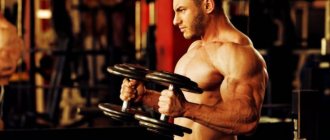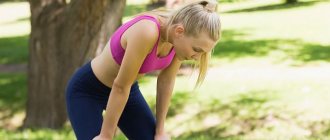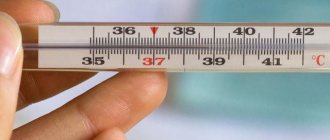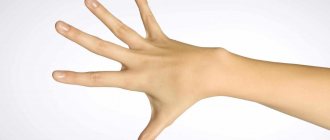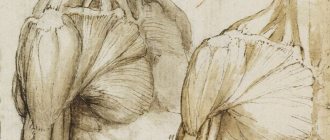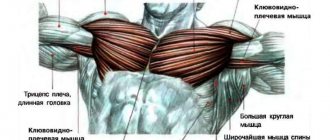Article provided by ironmonster.ru 2015-01-06 Views:
86 216
Grade:
4.3
| Medals articles >> |
Articles are loading...
Good day, friends! I’ll say right away that this article will not discuss the general principles of muscle growth; I have already covered all this in the article: Training program for gaining muscle mass. There is also a program specializing in pectoral muscles.
The post is intended for those whose chest muscles are lagging and refuse to grow according to standard training regimens.
Why don't muscles grow after training?
Training stimulates muscle growth if done with sufficient volume and intensity, and is also provided with sufficient recovery: nutrition and sleep.
Let's look at the word “sufficient” in the context of muscle growth.
In the Size/Quarter method, the sufficient amount of training for the first year of natural bodybuilding is 75 approaches per week. For the second - 100 approaches. For the third - 125.
Sufficient intensity is 60-70% for 6-8 repetitions per set or half the maximum for 12-16 repetitions.
In order for progress in strength to stimulate muscle growth, you need to do every fifth approach as you feel.
The diet of an athlete differs from the diet of a person suffering from a sedentary lifestyle in terms of protein/fat balance. The norm for an ordinary person in the protein/fat balance in terms of calories is 20/30, for an athlete it is 30/20 or at least 25/25.
The calorie intake should be about 40 kilocalories per kilogram of fighting body weight.
To grow muscles, you need to sleep more. One hour of training requires an additional two hours of sleep.
Muscles don't grow if:
- you do less than 75 approaches, - you do not do the approaches according to your health, - the nutritional balance is worse than 25/25, - you do not gain 40 kilocalories per kilogram of fighting weight, - do not sleep an extra six hours a week.
Create a strength training program
Sign up for an online consultation and find out why muscles don’t grow
Press with harnesses
Why is this necessary?
Along with various types of resistance, chest training is a great way to shock your muscles and make them stronger and bigger. You can do this with free weights and machines, but now it will be a different form of loading. The use of tourniquets entails using the muscle in an unusual form. This is especially effective in the press on the Smith machine.
“Using bands will increase the overall load on the muscle, and the resistance increases the higher you press the bar,” says Mark Duckdale.
What to do?
Next time you bench press on a Smith machine, attach bands from the edges of the barbell and secure them to the bottom of the machine. Use less weight than usual, taking into account the additional resistance of the harnesses. Your technique will not change, but you will notice that the resistance increases as you press the barbell higher. Do 2-3 sets of these, then move on to the next exercise, or do 1-2 more sets of Smith presses, but without bands.
Why don't loaders grow muscles?
Physical workers work 8 hours a day. This is good for muscle growth.
For example, CrossFitter Rich Froning, according to his wife, trains 8 hours a day, every day.
Sometimes he does strength exercises, sometimes metabolic exercises. On average, his workouts are not aimed at muscle growth, but at 175 cm tall, he weighs 94 kg and has 47 cm biceps.
This is the level of bodybuilders of the golden era.
Why do both the movers and Froning work 8 hours a day but look different?
A professional differs from an amateur in that after training, a professional goes to eat and sleep, while an amateur goes to work.
Where do loaders go after physical labor? Drink?
The question is not how stressed the movers are - the question is how do they recover?
Longshoremen who recover well look better than those who drink well.
Those who maintain a 25/25 balance and sleep norm recover well.
Create a training program
Training program for a beginner in the gym
1. Angle press is what you need.
The angle required is 30 degrees - in the hall it is often 45, it is not suitable. Take a bench and place it in a power rack. The grip of the bar should be at shoulder level, you will get maximum amplitude, and since the bench is at an angle, the load from the triceps and deltoids will partially decrease, moving to the pectorals. Here's what you need. Perform 4 sets of 12 repetitions.
2. Incline dumbbell presses are a great exercise. Mass, strength, development of the upper pectoral muscles - everything is there. It’s more difficult to do than with a barbell at an angle and you won’t lift as many kilograms. It’s great that the muscles of the abs, core, and legs are tensed to stabilize the body. The stretch of muscle fibers will be much greater, which is additionally shocking and easier to pump them up.
Perform 4 sets of 8 repetitions.
3. Dumbbell flyes in a horizontal position are the final isolated exercise, not for gaining mass. This single-joint exercise is necessary to shape the muscles, best done at the end of the session. Depending on the angle of inclination, the part of the muscles worked changes. Use a horizontal bench, it is better used and the pectoralis major muscle grows.
Perform 3 sets of 8 repetitions.
At first, 3 exercises will be enough if you practice 3 times a week. Training to pump up the pectoral muscles is designed to be done once a week.
1. The bench press is a legendary and famous exercise that shows upper body strength. To pump up your breasts with it, you need to know the technique. If you want to pump your chest using such a load, you need to learn to feel it. There are enough implementation options.
- The close-grip barbell press is usually used to pump up the triceps, but the inner chest also works well.
- The reverse grip press specifically targets the upper chest. For beginners, it is better to avoid it; you may drop the barbell, although this exercise has its advantages.
- The upside down barbell press works great for the lower pectoral muscles, but it is quite dangerous. It is strictly not recommended to take heavy weights; you are swinging from an upside down position, which means that the blood flow to the brain is too large, and the serious impact also creates the risk of a stroke. It is best to do it at the end of classes for the purpose of “finishing off”.
2. Dips use the entire pectoral muscle. You can further make the exercise more difficult; to do this, you need to do it with the body tilted forward (the pumping amplitude increases). However, the exercise is not very effective, because the triceps, deltoids, and back muscles work. It is better to use for gaining mass and strengthening the upper body, but not for pumping up the pectoral muscles.
3. The block pull in the crossover comes from the lower or upper blocks and acts on different parts of the chest. You can do wiring in it. Save the exercise for the end of the workout as a finisher. Don't chase the weight, work within 12 reps. Pumping in block rows goes well, which means no matter what part of the chest you pump, the muscles we need are literally filled with blood.
4. All types of dumbbell presses are very effective for gaining shoulder mass and increasing strength. The main advantage is that each part of the body works separately. In all people, one half of the body is more developed than the other. Thanks to dumbbells, you correct muscle asymmetry; the lagging arm will catch up with the leading arm in physical strength. Perform them after the barbell bench press or instead of it (as the main load).
5. Remember push-ups are a very good exercise for pumping up the pectoral muscles. It is rarely practiced in the gym, thereby missing out on an effective way to pump up the desired body parts.
4 sets of 10 reps. A given working weight, for example, 100 kg, divide by 0.65, you get a one-repetition maximum = almost 154 kg; if it was done easily, divide by 0.6, if it was done hard, by 0.7. Next, in each workout, you calculate the main weight for each exercise, where the % stands, taking the one-repetition maximum as 100%. For example, a bench press at the first workout of 55% of 154 kg will be equal to almost 85 kg.
Why did muscles stop growing?
The larger the muscles, the more they require for further growth.
For example, in the “Size/Quarter” method, the first year of training is 75 sets of strength exercises per week, the second year is 100 approaches, the third year is 125 approaches.
Moreover, to gain the first 10 kg, you need to do 75 approaches per week, and to gain the last 2 kg - 125 approaches.
People who don't understand that it's easy to grow from scratch think that muscles stop growing after just 2 months of training. Simply, Nature gives the first 5 kg of muscle practically for nothing.
Create a strength training program
Follow the news on VKontakte/Facebook/Instagram
Short range presses
Why is this necessary?
“If you end a set because you can't complete a full rep (meaning pressing the barbell from touching your chest to pushing it all the way up), then you're not really challenging the muscle,” says Jim Stoppani. “If you keep pressing at the lower end of the range until you can’t move the barbell/dumbbells, you will discover the true potential of your pecs.”
For the chest, such presses are good in Smith, in machines and in dumbbell presses. Because the triceps play an important role in the press in the upper half of the range, you may not always be able to complete a full rep, but your chest is still ready to work. Continuing to do the bench press at the bottom of the amplitude, you turn off the triceps and can effectively “kill” the chest.
What to do?
In the last (or last two) approach of these exercises, press as usual, at full amplitude; when you cannot do full repetitions, continue to do presses at half amplitude - 3/4 amplitude until you can not do presses even at half amplitude.
Basic information. Where would we be without her?
Everyone is different and everyone's chest is different too. For some it is wide, for others it is narrow. The narrower the chest, the easier it is to increase the volume of muscle mass in the chest, thereby raising the chest above the ribs. Actually, the wider, the more difficult it is to do this. The secret is that it is always easier to increase the size of a short muscle, but do not despair; bodybuilding can offer several training programs that can smooth out this problem. Most amateurs do not know the anatomical structure of different muscle groups, and this is very bad!!! The knowledge gap significantly increases the time it takes to achieve success in the gym. First you need to know that all muscles are made up of striated fibers, which contract. Based on this, the key role is played by the position of the hands, the angle of inclination of the torso and arms relative to it when performing the exercise.
Chest exercises: anatomy
From an anatomical point of view, the main muscles of the chest are the pectoralis major and minor muscles. The pectoralis major muscle has a triangular shape, intertwining one of its bases directly into the shoulder - it is thanks to this that the muscles of the chest and shoulders are closely connected. The pectoralis minor muscle is located under the major muscle and plays a stabilizing rather than working role.
In addition, the pectoral muscle group also includes the serratus anterior muscle, which lies closer to the side of the body and to the shoulder. This muscle has nine characteristic “teeth” attached to the upper ribs. Its main function is to abduct and approximate the shoulder blades - in fact, it is the serratus anterior muscle that works in such chest exercises as all kinds of information.
The best exercises for chest muscles
Note that most exercises for the pectoral muscles can be performed with a barbell, dumbbells or on blocks. Dumbbells and blocks allow you to use stabilizer muscles in the exercise and specifically pump individual sections of the chest, while the barbell is the preferred choice when working with heavy weights, since its range of motion is usually reduced.
1. Push-ups are a key anatomical exercise for the chest muscles. If you want to pump up your chest, you first need to learn how to do push-ups correctly so that you can feel the pectoral muscles in action. However, we note that push-ups have an extremely limited resource for breast growth, since they do not allow you to work with additional weight.
2. Dips are one of the best exercises for comprehensively working the upper body, and especially the lower pectoral muscles, the entire shoulder girdle and triceps. When going down, the movement should be slow and controlled, when going up, it should be powerful and jerky (as if you are pushing your body up).
3. Bench press is a basic strength exercise for the pectoral muscles. When performing the bench press, it is extremely important to pay attention to your technique - do not relax the muscles at the top and bottom of the movement, do not straighten your elbows and never touch the barbell to your chest. Raise the barbell up, slowly counting 1-2, hold for 3-4 and lower it for a count of 5-6.
4. Lying dumbbell flyes are a key exercise for working the serratus anterior muscle and giving the chest the correct “square” shape. Use dumbbells that are not too heavy, focusing primarily on the feeling of the muscle stretching. At the bottom of the movement, do not drop your elbows too low or spread your arms too wide.
5. Incline dumbbell press - an exercise to work the upper part of the pectoral muscles. When performing the exercise, do not lift your feet off the floor and make sure that the core muscles (especially the abs) are in constant slight tension - when lifting the dumbbells, you should feel how this tension helps push the weight up.
Training process
The most common mistake in the gym is focusing on the same exercises and movements. If you think about the structure of the chest, then all the fibers are located at different angles. If you perform only one exercise and perform it in one plane, then we see the result only in one place. Let's take the bench press as an example. If you perform it correctly, the bar moves vertically and touches the chest in the area of the nipples, that is, in the middle. The breasts grow in the middle, but the top and bottom of the chest remain undeveloped. That is why it is necessary to introduce exercises into the training process that allow you to engage lagging areas. Crossover raises, dumbbell flyes, or incline presses. All these exercises will help you achieve a positive result. But the pectoralis minor muscle still contracts minimally when performing these exercises...
Lack of mental brain-muscle connection (in this case, brain-pectoral muscles).
By the way, the previous reason (exercise technique) is very closely intertwined with this reason. Why? => Yes, because you have the correct (ideal) technique for performing this or that exercise, it will be much easier for your brain to contract the muscles you need (in our case, these are the pectoral muscles).
CONCLUSION: the better your technique is developed (+ mental connection between BRAIN and MUSCLE), the faster you will grow (in our case, increase the mass of your pectorals).
It also happens that a person has good technique for performing an exercise, but there is no mental connection between the brain and muscle, therefore, his muscles will not contract as efficiently as they could. But if you have the right technique (ideal) + a developed mental brain-muscle connection, then your muscles will contract as efficiently as possible! As efficient as possible. Draw your own conclusions.
Read the main article: “MENTAL BRAIN-MUSCLE CONNECTION.”
